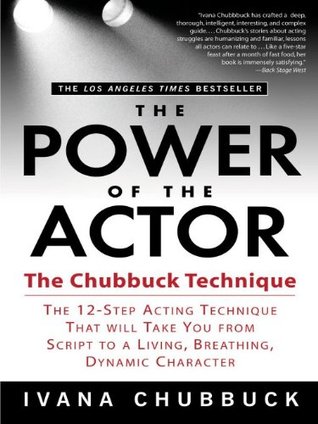Kindle Notes & Highlights
Using recent painful circumstances from your life keeps you present and raw because you are still unaware of the ramifications of how it will resolve itself.
good INNER OBJECT choices will stick. You won’t have to think about it—the pictures will emerge, organically and naturally.
Handwrite each INNER OBJECT choice directly beneath the word(s) that it’s attached to.
write in Michael’s personal INNER OBJECTS under the words that require INNER OBJECTS, which will be underlined. It will be handwritten exactly how and where you would write in the specific and personal INNER OBJECT choices.
Remember: INNER OBJECTS include the mental images of a person, place, thing or event that you talk about or that you hear the other person talk about.
A BEAT is a thought change.ACTIONS are mini-OBJECTIVES attached to each BEAT. BEATS and ACTIONS are the various approaches one takes to achieve the SCENE OBJECTIVE.
A BEAT can be one word, one line, or even as much as a page of dialogue.
The criterion for a BEAT change is when the dialogue indicates a new thought.
might change when you are saying the words out loud.
might differ depending upon how the other actor(s) are responding to you.
BEATS and ACTIONS are mini-OBJECTIVES.
more precisely worded than your SCENE OBJECTIVE and must support the forward motion necessary to win your SCENE OBJECTIVE.
As you go after a BEAT and ACTION verbally, you’ll find that your body feels compelled to join in the pursuit. Thus behavior is formed.
If you don’t require a reaction from the other actor(s), you diminish them and weaken your ability to win your SCENE OBJECTIVE.
BEAT and ACTION choices are all worded to get a reaction, so that you can establish interaction with the other person and, thus, a relationship.
Feelings do not provoke a reaction.
Phrasing your ACTIONS as inactive feelings causes an introspective result as well as a reality that has no goal, need or desire for human interaction.
Ask yourself, “What do I want to win (SCENE OBJECTIVE)? And how is the best, most effective way (both verbally and behaviorally) to achieve it (BEATS and ACTIONS)?”
The ACTIONS must support the SCENE OBJECTIVE to create a focused thread that weaves throughout the entire scene.
also have to make the other character want to give you your SCENE OBJECTIVE, by making the most effective choices for BEATS and ACTIONS.
Apply BEATS and ACTIONS to Nonverbal Moments
Even though no words are spoken, you are still going after a BEAT and ACTION:
When you stop talking and the other person is speaking, you must continue to attempt to get the desired reACTION with behavior.
Keep in mind the “who-am-I” of your character, the specific M.O. of how your character would be most effective in winning the SCENE OBJECTIVE.
always keep in mind who the character is and how they generally operate in life when making specific BEAT and ACTION choices.
You also have to consider the type of person the other character is, which will help you determine how to get what you want.
they’re more likely to give you what you want if they’re getting what they want.
Every how, why or what means something. Imagine making a throwaway comment while someone is holding a gun to your head. It wouldn’t happen.
Every scene should be about trying to resolve, overcome and accomplish something that is extremely valuable or meaningful to you, too.
Everything you say or do should advance the accomplishment of your goal,
making the use of BEATS and ACTIONS imperative for the entire script.
You will have a different emotional reaction depending upon how the other person responds to your BEAT and ACTION.
It’s important to go after your BEAT and ACTION and then see what kind of reaction you’re getting, feel it (the good and the bad) and then respond accordingly.
what usually makes us laugh is not what someone says, but what someone does.
BEATS and ACTIONS not only serve the dialogue, but also create behavior that goes along with it.
take this scene and break it down into BEATS, indicated by brackets, and ACTIONS (mini-OBJECTIVES or tactics), which are always handwritten (in pencil) on the side to the right.
Like all the tools, they can change upon your personal interpretation.
BEATS and ACTIONS inspire an actor to physicalize the dialogue, making the experience more three-dimensional and relationship focused.
The test for any good performance is to be able to cut the sound and still be able to laugh, cry and feel because the BEATS and ACTIONS reveal and drive the character’s intentions.
may be doing a scene in which your character is talking about how much they loved and respected some piece of literature. The truth is they may have never read the book or did read it and thought it was boring, but they’re saying they liked it because they want to impress the other person with their brilliance, or simply to make the other person like them.
Remember: Bracket your BEATS and write your ACTIONS to the right side of the BEAT so you know exactly the words they connect to.
Depending upon how her co-star Peter Skarsgaard responded, she would change her BEATS and ACTIONS accordingly.
Your BEAT and ACTION approaches must support the character’s SCENE OBJECTIVE, which supports the OVERALL OBJECTIVE.
In Elisabeth’s case, the SCENE OBJECTIVE for this particular scene in Burn This was “to make you prove that you love me,” which supported her character’s OVERALL OBJECTIVE of “to find passion in my life again.”
Look at BEATS and ACTIONS as a subset of SCENE OBJECTIVE,
and SCENE OBJECTIVE as the subset of
your OVERALL OB...
This highlight has been truncated due to consecutive passage length restrictions.
There are three questions you must ask yourself when looking for your MOMENT BEFORE:


